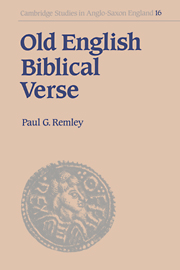Book contents
1 - Introduction
Published online by Cambridge University Press: 30 September 2009
Summary
The Junius manuscript offers verse without context. The biblical emphasis of the Old English poetry in the collection is clear enough: the verse of Genesis, Exodus and Daniel is indeed given over in bulk to renditions of passages from the Old Testament books that lend these compositions their modern names. The final item, Christ and Satan, treats apocryphal and New Testament episodes. But far from certain are the origins, authorship, dates, sources, intended uses and transmission-histories of these vernacular biblical poems, or reflexes of poems, which have come down to us joined in a medieval leather binding, their texts copied out in a regular script and enlivened at times by dramatic scriptural illustrations. Their single surviving witness is Oxford, Bodleian Library, Junius 11 (s. x/xi; later provenance? Christ Church Cathedral, Canterbury)–here cited as ‘Junius 11’ or, less precisely, the ‘Junius manuscript’. Junius 11 was produced in the later Anglo-Saxon period, in all probability around the year 1000, but the composition of the verse that it preserves is often dated to c. 700 or earlier. Whatever conclusions are drawn regarding the specific chronology of the verse and its exemplars, the evident breadth of the gulf separating the composition of the Junius poems and the execution of their surviving copy, taken together with the fact that no comparable collection of Old Testament poetry has survived to the present day, may justify the statement that the verse of Junius 11 has no known literary-historical context before c. 1000.
THE LOST TRADITIONS OF THE JUNIUS POEMS
The consensus of modern scholarship holds that the Junius poems were composed by different poets, or different schools of poets, most probably over many decades and at a number of geographically dispersed Anglo-Saxon centres.
- Type
- Chapter
- Information
- Old English Biblical VerseStudies in Genesis, Exodus and Daniel, pp. 1 - 93Publisher: Cambridge University PressPrint publication year: 1996

